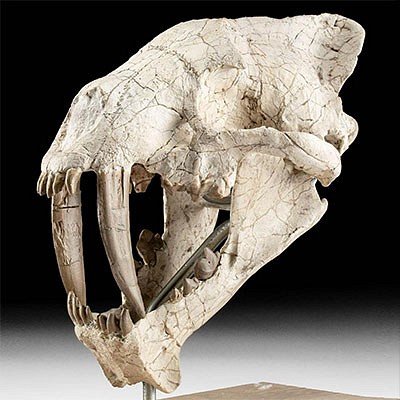Early 20th C. African Bwa Polychrome Wood Hawk Mask
Lot 73
About Seller
Artemis Gallery
686 S Taylor Ave, Ste 106
Louisville, CO 80027
United States
Selling antiquities, ancient and ethnographic art online since 1993, Artemis Gallery specializes in Classical Antiquities (Egyptian, Greek, Roman, Near Eastern), Asian, Pre-Columbian, African / Tribal / Oceanographic art. Our extensive inventory includes pottery, stone, metal, wood, glass and textil...Read more
Estimate:
$700 - $1,050
Absentee vs Live bid
Two ways to bid:
- Leave a max absentee bid and the platform will bid on your behalf up to your maximum bid during the live auction.
- Bid live during the auction and your bids will be submitted real-time to the auctioneer.
Bid Increments
| Price | Bid Increment |
|---|---|
| $0 | $25 |
| $300 | $50 |
| $1,000 | $100 |
| $2,000 | $250 |
| $5,000 | $500 |
| $10,000 | $1,000 |
| $20,000 | $2,500 |
| $50,000 | $5,000 |
| $100,000 | $10,000 |
| $200,000 | $20,000 |
About Auction
By Artemis Gallery
Jul 13, 2021
Set Reminder
2021-07-13 12:00:00
2021-07-13 12:00:00
America/New_York
Bidsquare
Bidsquare : Fauna, Flora, Stones & Bones
https://www.bidsquare.com/auctions/artemis-gallery/fauna-flora-stones-bones-7214
Join us for a very special summer auction featuring fabulous fossils, rocks, and minerals, plus art depicting flora and fauna from antiquity to present day. This is one you won't want to miss! Artemis Gallery info@artemisgallery.com
Join us for a very special summer auction featuring fabulous fossils, rocks, and minerals, plus art depicting flora and fauna from antiquity to present day. This is one you won't want to miss! Artemis Gallery info@artemisgallery.com
- Lot Description
West Africa, Burkina Faso, Bwa peoples, ca. early to mid-20th century CE. A splendid and sizeable wooden mask depicting a nature spirit in the form of a stylized hawk or vulture, known as a duho. Embellished in white, red, and black pigments, the impressive vizard presents a lengthy, horizontal body resembling a pair of wings that spans over 4 feet and curves upward at each end. A pair of concentric circle eyes gaze outwards, flanking a conical open mouth at the center of the piece. The wings are decorated with several horizontal registers of a triangular pattern. An annular, recessed area, which likely previously held the hooked beak, is featured just above the mouth. The verso is also adorned with bold geometric designs and an ovoid area surrounded by circular drill holes, allowing the mask to be worn. Traditionally, masks like this example were worn by performers who would bite a thick fiber rope tied to the drill holes of the verso to hold the mask to their face. Size: 52.5" L x 11.75" W (133.4 cm x 29.8 cm)
According to the Metropolitan Museum of Art, "In Bwa society, the identity and continued well-being of a family are often tied to a nature spirit. The origin of this association may be a dream or even an encounter with a spirit who materializes in animal form. Upon consulting a priest, a family may commission a sculpture to embody that nature spirit. The masks appear at important funerals to honor the dead and escort their soul to the world beyond. They also dance at agricultural festivities to ensure the proper progression of the seasons, and at initiation rituals to help introduce young men and women to the secrets and responsibilities of adulthood. The masks are the object of family pride and are also an unofficial means of representing its prosperity and influence. Rival families will compete to assemble the most innovative and spectacular performances. Consequently, families will commission the carving of a multitude of masks—as many as nine different masks may represent an individual extended family. The elaborate decorations, the impressive size and design of the mask, as well as dynamic choreography all add to the grandeur and prestige of the event."
Provenance: private Houston, Texas, USA collection, acquired in the late 1980s to as recently as 2017
All items legal to buy/sell under U.S. Statute covering cultural patrimony Code 2600, CHAPTER 14, and are guaranteed to be as described or your money back.
A Certificate of Authenticity will accompany all winning bids.
PLEASE NOTE: Due to recent increases of shipments being seized by Australian & German customs (even for items with pre-UNESCO provenance), we will no longer ship most antiquities and ancient Chinese art to Australia & Germany. For categories of items that are acceptable to ship to Australia, please contact us directly or work with your local customs brokerage firm.
#165924Missing beak. Some expected chips, nicks, and abrasions. Otherwise, excellent with nice remaining pigments.Condition
- Shipping Info
-
All shipping is handled in-house for your convenience. Your invoice from Artemis Gallery will include shipping calculation instructions. If in doubt, please inquire BEFORE bidding for estimated shipping costs for individual items.
-
- Buyer's Premium



 EUR
EUR CAD
CAD AUD
AUD GBP
GBP MXN
MXN HKD
HKD CNY
CNY MYR
MYR SEK
SEK SGD
SGD CHF
CHF THB
THB













